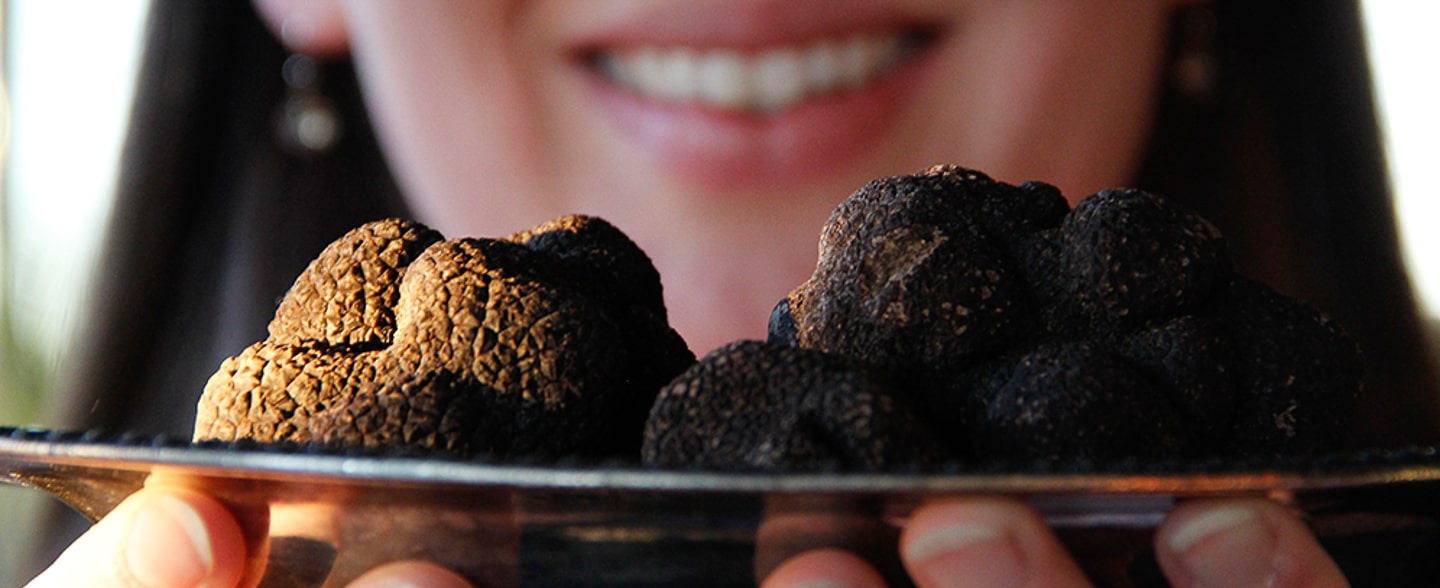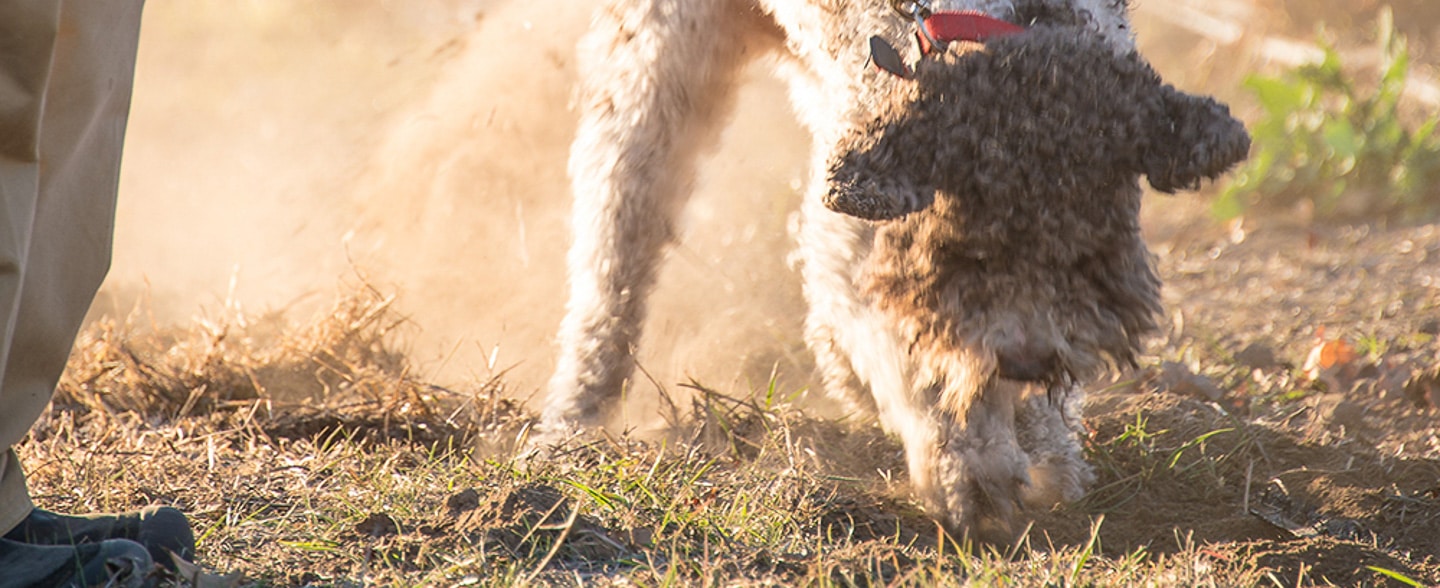But wait—what exactly is a truffle, anyway? We teamed up with some truffle experts from around the world to uncover the mysterious secrets of the world-famous truffle.
Meet our panel of experts:
- Robert Chang, Managing Director and Chief Truffle Officer for American Truffle Company. He is the founder along with his partner Dr. Paul Thomas, Chief Scientist.
- Umberto Lucherini, owner of La Chiusa Hotel and Restaurant in Tuscany. Umberto’s wife and famed chef Dania has been serving truffles at their restaurant for more than 40 years to thousands of guests!
- Massimo Vidoni, owner of Italtouch, a company that imports Italian truffles, caviar, and specialty food to make these delicious delicacies accessible to the world!
- Radka Ramain, DuVine France bike tour guide, lives in France and has been truffle hunting with her dog Elmo for many years.
What is a truffle?
A truffle is a kind of fungus that grows on the roots of certain species of trees. “The word comes from the Latin ‘tuber’ because it looks like a swelling, and truffles are part of the tuber family of fungi,’ says Radka. Truffles grow underground and are often categorized with mushrooms, their more commonplace cousin, so they are often nicknamed “underground mushrooms.”
The main types of edible and sought-after truffles are the white truffle, black winter truffle, and black summer truffle.
Where do truffles grow?
There more than 1600 species of truffles found in the wild, and various species of truffles are native to all continents except Antarctica. “Among all those species, there are around seven that are really edible,” says Massimo Vidoni. The most prized species, the White Alba Truffle (also known as Alba Madonna) and the Black Perigord Truffle, are native to southern Europe.
Black truffles are now being farmed in Australia and the U.S., and they continue to reach higher standards of quality in size and taste. According to Robert Chang, American Truffle Company‘s Dr. Paul Thomas is getting closer each day to cracking the code to cultivation of the white truffle in the U.S.

What’s the difference between black and white truffles?
White Truffle | Black Summer Truffle | Black Winter Truffle | |
| Color | White | Black | Black |
| Aroma + Flavor | Most Pungent | Least Aromatic | Sweet + Delicate |
| Fun Fact | “When you smell the white truffle, you feel it in your nose. When you smell the black truffle, you feel it in your throat,” says Massimo Vidoni | ||
| Primary Origin | Piedmont, Tuscany + Umbria in Italy | Burgundy, France | Dordogne + Provence in France + Perugia, Italy |
| Price | $2,000-$5,000 per pound | $1,000 per pound | $1,000-$2,000 per pound |
| Fun Fact | Truffles were named by 60 Minutes as “The Most Expensive Food in the World” | ||
| Rarity | Most Rare | Most Common, but Still Rare | Most Common |
| Season | September to December | August to December | November to March |
| Fun Fact | There is also a truffle called the “Marzolino Truffle” that can be found in Italy between January and March, says Umberto Lucherini | ||
Do the truffles that grow in different regions or countries differ from each other?
Yes. Truffles are also known as tubers, truffas, tartufi , truffe, and faggah in different parts of the world. “Besides their names and species in different regions, indigenous truffles also differ even from valley to valley depending on the climate and soil,” says Massimo—much like the terroir of each variety of grape.
Are truffles mushrooms?
Both truffles and mushrooms belong to the Fungi kingdom in scientific classification. However, mushrooms grow above ground and truffles grow underground on the roots of suitable host trees, like oak or hazelnut. “To me they are totally different,” says Massimo. “The aroma is just so different.”
What do truffles taste like?
Even the experts cannot describe the flavor of a truffle. “It is completely unique,” says Massimo, “and most people either love it or hate it.” You will only know by trying it yourself, and the best way to try it is fresh, wild, and in France or Italy!
Are truffles more expensive in different regions of the world?
“Yes, but not significantly,” says Robert Chang. “Transportation costs are included but minimal compared to the value of the truffle itself.”
Why are truffles so expensive?
The price of truffles is based purely on supply and demand. Robert explains that as demand grows year over year while supply is relatively constant, we have seen truffle prices increase about 4-5% annually.
However, truffle price depends on the season and can rise or fall depending on the season’s yield. More rain means more spores, which means more truffles and a lower price, so pray for rain!
How much do restaurants really mark up the price on truffles?
Massimo estimates that most restaurants need to double or triple the cost to break even, but the price depends on many factors. “For example, white truffles are so delicate that if you buy a kilo, they start losing 5% of their weight each day,” he says. After a few days, the aroma may change or disappear, or they can go black. Restaurants must check their truffle supply when it arrives and every day.
How can you tell which truffle is better than another? Does size matter?
Surprisingly, size doesn’t matter. “Larger truffles may be ‘better’ in the sense that they are more presentable if they are shaved tableside,” says Robert, “but once they are shaved, there is no difference whatsoever compared to a smaller truffle of the same freshness in terms of aroma or taste.”
Truffle hunters and chefs look for aroma, variety, freshness, firmness, maturity, color, and no deterioration caused by predators. The most important attraction for a truffle is its aroma, says Umberto, which is directly related to how fresh it is.
Are truffles really harvested using pigs?
Truffles are harvested by hand using either pigs or trained dogs to pinpoint their location. Throughout history, pigs were more commonly used to hunt truffles as they generally have sharper noses and do not need to be trained. Today, dogs are used almost exclusively and are preferred by truffle hunters as they don’t eat the truffles, like pigs do, and they are more efficient and much easier to handle. “It’s not easy to go around unnoticed with a few hundred kilos of pigs in the back of your car,” says Massimo.
However, the method of actually digging the truffles out of the ground by hand—that hasn’t changed for centuries!
Can anyone hunt truffles?
Hunting truffles requires a nose, a well-trained dog, and a map in your mind passed down for generations. Most wild truffle hunters do not divulge the location of their truffle finds, but many truffle hunters offer truffle hunting experiences for visitors to France and Italy. “Going out with a truffle hunter is a really great experience,” says Massimo. “It’s the only way to truly appreciate nature and the hard work of hunting truffles.”
How are truffle dogs trained?
Most truffle dogs come from two truffle dog parents, and truffle training starts when a dog is just a pup. “Truffle oil is applied to the mother as the puppies are feeding so they get the taste for it, and puppies are often fed truffles as treats,” says Radka Ramain. This is how they trained her truffle dog, Elmo!
How long do they keep?
Truffles behave like radioactive material, says Robert. “They have a half-life of about four to five days. As soon as they come out of the ground, the aromas start dissipating. After four to five days, only half of the aromas remain. After eight to ten days, only a quarter of the aroma is there. After that, they are no better than the mushrooms you buy from the supermarket.”
Can truffles be preserved?
If you freeze truffles, they are a bit soft to use. “Dehydration changes the flavor profile, and you lose the crunchiness which is big part of the pleasure of eating one,” says Radka. Most agree that nothing is as good as fresh truffles, and many chefs use only fresh truffles for this reason.
It is possible to preserve the real fresh white truffle, so chefs may use truffle butter, oil creams, sauces, and even truffle honey that are easy to control and are always available any time of year. When purchasing truffle oil or truffle salt, beware! Robert warns that some salts and oils are synthetic and use chemical ingredients that mimic the flavor of truffle. If you’re looking for a reliable truffle product, Italtouch’s true truffle oil is much beloved by chefs all around the world!
Can I grow truffles at home?
The easy answer? No, you cannot grow your own truffles. “Many people have tried to plant them in their gardens or even in their orchards, but very few have been successful,” says Robert.
Truffle farming technology is moving quickly, and scientists in the U.S. and Australia have learned to cultivate black truffles with extensive research, scientific knowledge, and the perfect conditions.
“The most you can do at home is plant the right trees and hope,” says Massimo. Truffles really need nature at its best, which is why they are so rare, so expensive, and so special!

Will the world ever run out of truffles?
Massimo’s answer? “I really hope not! As I am called ‘the Truffle Man,’ it will be the end of me!”
The world is unlikely to run out of truffles, but it is nature that will decide. But one thing is for sure—the disparity between supply and demand can and will continue to increase, making truffles rarer and more expensive.
The only true way to answer the question “What is a truffle,” is to experience one for yourself! Travel with DuVine on a Piedmont Truffle Bike Tour and find out what’s so special about this unique and mysterious ingredient. Contact us to start planning your Piedmont, Tuscany, Dordogne ,or Provence bike tour and experience the flavors of the black or white truffle first-hand.







